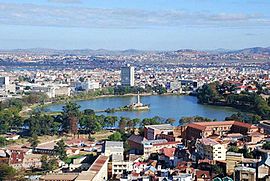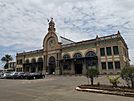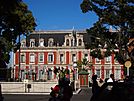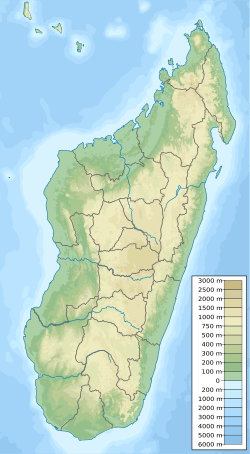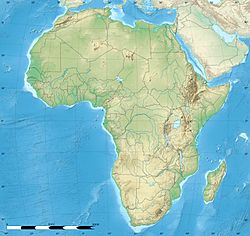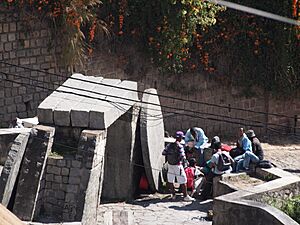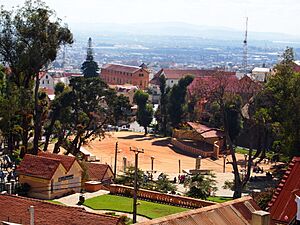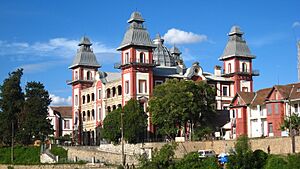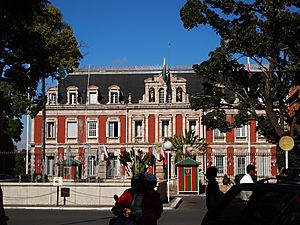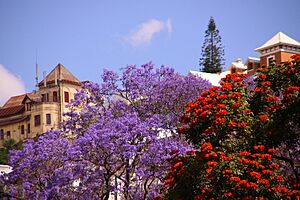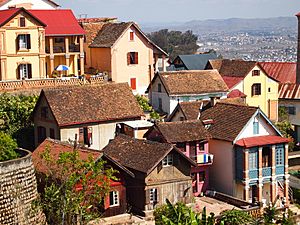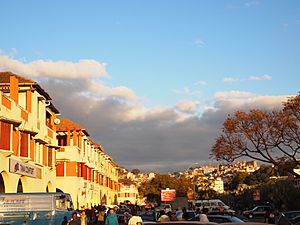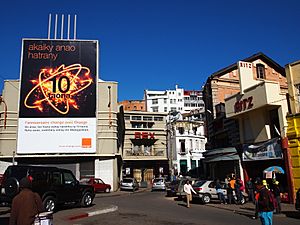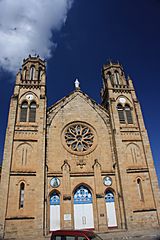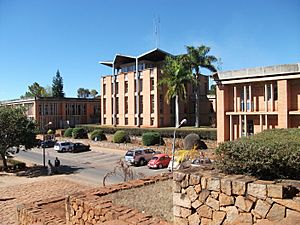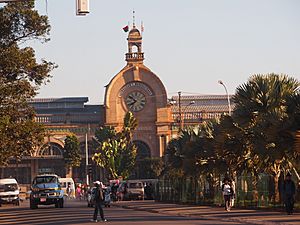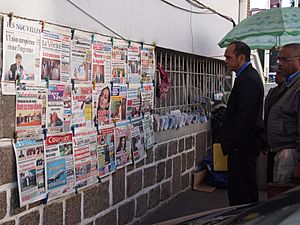Antananarivo facts for kids
Quick facts for kids
Antananarivo
Tananarive
|
|||
|---|---|---|---|
|
Left to right: Lake Anosy Central Antananarivo, jacarandas blooming, Lake Anozy, royal chapel, bust of Philibert Tsiranana, Mausolée national Andrainarivo, train station, presidential office
|
|||
|
|||
| Nickname(s):
Tana
|
|||
| Country | |||
| Region | Analamanga | ||
| Historic Countries/Colonies | Merina Kingdom Malagasy Protectorate French Madagascar |
||
| Founded | 1610 or 1625 | ||
| Area | |||
| • Capital city | 85 km2 (33 sq mi) | ||
| Elevation | 1,276 m (4,186 ft) | ||
| Population
(2018 Census)
|
|||
| • Capital city | 1,274,225 | ||
| • Density | 14,990/km2 (38,830/sq mi) | ||
| • Urban | 2,300,000 | ||
| Time zone | UTC+3 (East Africa Time) | ||
| Area code(s) | (+261) 023 | ||
| Climate | Cwa | ||
| Major Airport(s) | Ivato International Airport | ||
| Website | www.mairie-antananarivo.mg | ||
Antananarivo (pronounced An-tah-nah-nah-REE-voh), often called Tana for short, is the capital and largest city of Madagascar. It sits high up in the center of the island, about 1,280 meters (4,200 feet) above sea level. This makes it the highest capital city among island countries.
Antananarivo has been the biggest city in Madagascar for a long time. It is where the country's main government buildings are located. You'll find the President's office, the National Assembly, and the Supreme Court here. Many international offices and businesses also have their main bases in Antananarivo.
The city is home to more universities, fun places, art spots, and hospitals than any other city on the island. It's also where many national sports teams are based, including the famous Makis rugby team.
Antananarivo was once the capital of the Merina people. They still make up most of the city's 1.27 million residents. If you include the areas around the city, the total population is almost three million people. People from all 18 Malagasy ethnic groups live here. You'll also find people of Chinese, Indian, European, and other backgrounds.
The city was founded around 1610 or 1625. A Merina King named Andrianjaka took over a village called Analamanga. He built a fortified royal home called a rova there. This rova grew into the royal palaces of the Kingdom of Imerina. The city was called Analamanga until King Andriamasinavalona renamed it Antananarivo, which means "City of the Thousand," to honor King Andrianjaka's soldiers.
Antananarivo was the capital of the Kingdom of Imerina until 1710. Then, the kingdom split into four parts. Antananarivo became the capital of the southern part. In 1794, King Andrianampoinimerina brought the kingdom back together. He made Antananarivo the capital again. His son, Radama I, continued to expand the kingdom. He controlled over two-thirds of the island. European countries then saw him as the King of Madagascar. Antananarivo stayed the capital even after France took over in 1897 and after Madagascar became independent in 1960.
Today, the city is managed by the Commune Urbaine d'Antananarivo (CUA). The city faces challenges like crowded areas, traffic, and managing waste. There are also issues with pollution and getting enough water and electricity for everyone. These problems are linked to the city's fast growth.
Some important places to visit in Antananarivo include the rebuilt royal palaces and the Andafiavaratra Palace. You can also see the tomb of Rainiharo, the Tsimbazaza Zoo, Mahamasina Stadium, and Lake Anosy. There are also four 19th-century churches that remember early Christians. The Museum of Art and Archaeology is also a great place to learn.
Contents
Understanding the City's Name
The name Antananarivo means "City of the Thousand." It comes from the Malagasy language. The city was first called Analamanga, which means "Blue Forest." This name was used by the Vazimba people, who were the island's first inhabitants.
King Andrianjaka took over the area and made it his capital. Oral stories say he used 1,000 soldiers to capture and protect the site. Later, King Andriamasinavalona renamed it Antananarivo to honor those soldiers.
A Look at Antananarivo's History
Antananarivo was an important city long before European countries arrived.
Early Days of the Merina Kingdom
After King Andrianjaka took over Analamanga hill, he built his royal compound, the rova. This compound grew to include royal palaces and tombs. The city was founded around 1610 or 1625. Early Merina kings used a system called fanampoana (forced labor) to build large rice fields around the city. These fields, like the Betsimitatatra, still produce rice today.
Later, King Andriamasinavalona gave the city its current name. He created the Andohalo town square outside the city gate. Kings and queens would give speeches to the public there. He also divided the city into areas for different groups of people. These rules were very strict. For example, non-nobles could not build wooden houses. Pigs were also not allowed inside the city.
After Andriamasinavalona died in 1710, the kingdom split into four parts. Antananarivo became the capital of the southern part. A civil war lasted for 77 years. During this time, the capital of the eastern part, Ambohimanga, became very important. In 1793, King Andrianampoinimerina from Ambohimanga captured Antananarivo. He reunited the kingdom and moved the capital back to Antananarivo in 1794. He made Ambohimanga the spiritual capital. King Andrianampoinimerina also created a large market in Analakely, making it the city's economic heart.
Antananarivo as Capital of Madagascar
By 1810, when King Radama I took the throne, Antananarivo was the biggest and most important city on the island. It had over 80,000 people. Radama welcomed the first European settlers, who were missionaries. They arrived in 1820 and started the city's first public schools. A missionary named James Cameron taught people how to make bricks. He also created Lake Anosy to power factories. Radama also set up a military training area called Mahamasina.
Radama I brought most of the island under his control. British diplomats recognized him as the "ruler of Madagascar." After this, the Merina kings declared Antananarivo the capital of the entire island.
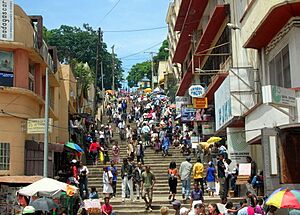
King Radama's successor, Ranavalona I, invited a craftsman named Jean Laborde to build the tomb of Prime Minister Rainiharo. Laborde also built Manjakamiadana, the largest palace at the Rova, between 1839 and 1841. Ranavalona I also improved the city's roads. She built two large staircases at Antaninarenina and Ambondrona. These connected the middle part of the city to the main market.
In 1867, Queen Ranavalona II allowed buildings to be made of stone and brick. Before this, only tombs could be made of stone. Missionaries built the first brick house in 1869. It mixed English, Creole, and Malagasy styles. This new style, called trano gasy ("Malagasy house"), quickly spread. These houses were usually two stories, made of brick, with a wooden porch. They replaced many old wooden houses. Many stone churches were also built for the growing number of Christians. Four special churches were built to remember early Malagasy Christians who faced difficulties under Ranavalona I.
Until the mid-1800s, the city was mostly around the Rova on the highest hill. This area is now called la haute ville (upper town). As the city grew, it spread west. By the late 1800s, it reached the northern area of Andohalo. British missionaries made this a popular place to live.
From 1864 to 1894, Prime Minister Rainilaiarivony ruled Madagascar with three queens. He made many changes to the city. In 1881, he brought back mandatory education. This led to many new schools and colleges. He also built the nation's first pharmacy, medical college, and modern hospital. Rainilaiarivony built the Andafiavaratra Palace in 1873 as his home and office.
French Colonial Period
The French military took over Antananarivo in September 1894. The queen surrendered after a cannon hit a building at the Rova. The French kept Antananarivo as their capital and called it Tananarive. They built the French Governor General's Residency in Antaninarenina. After independence, this building became the Ambohitsorohitra Palace, used as presidential offices.
Under French rule, tunnels were built through two large hills. This connected different parts of the city and helped it grow. Streets were paved, and sewer systems and electricity were added. Water was brought from the Ikopa River.
The city's middle area, la ville moyenne, grew a lot during this time. It spread along the lower hills. Modern city planning was used in the lower town, la ville basse. This area grew from the base of the hills into the surrounding rice fields. Big roads like Avenue de l'Indépendance, shopping areas, parks, and city squares were built. A railway system was also built in 1897. It connected Antananarivo to Toamasina and Fianarantsoa.
Antananarivo grew quickly after World War II. By 1950, it had 175,000 people. Roads connecting the city to nearby towns were improved. The first international airport was built outside the city. It was replaced in 1967 by Ivato International Airport, closer to the city center. The University of Antananarivo was built, along with the Museum of Ethnology and Paleontology. In 1959, floods in the lower town led to new walls being built along the rice fields. New government buildings were also built on drained land.
Antananarivo After Independence
After Madagascar gained independence in 1960, the city grew even faster. By 2013, the population was almost 2.1 million. This fast growth has put a strain on the city's services. There are problems with clean water, electricity, and waste management. Traffic is also a big issue.
The city has over 5,000 churches. Antananarivo has also seen many large protests and political events.
City Layout and Architecture
Antananarivo is built on three hills that meet at their highest point. The Manjakamiadana royal palace is at the very top. You can see it from all over the city. This palace was the biggest building in the Rova. A fire in 1995 damaged it, but it has been restored. The city's skyline is a mix of colorful, old houses and churches. Newer buildings and family rice fields are in the lower areas. The Betsimitatatra rice fields surround the city.
The city's neighborhoods reflect its history. In the past, different noble families lived in specific areas. The highest-ranking nobles lived closest to the royal palace, in the higher parts of the city. This pattern continued even after French rule.
Today, the haute ville (upper town) is mostly residential. It's seen as a fancy place to live. Many wealthy families live there. The part of the haute ville near the Rova has many old buildings. It includes the royal palace, the Andafiavaratra Palace (former home of Prime Minister Rainilaiarivony), and Andohalo square. There's also a cathedral built to remember early Christian martyrs.
The ville moyenne (middle town) is very lively and crowded. It has homes, historic sites, and businesses. The Antaninarenina neighborhood has the historic Hôtel Colbert, jewelry shops, and government offices. Other important neighborhoods in the middle town are Ankadifotsy, Ambatonakanga, and Isoraka. Isoraka has become known for its nightlife, with restaurants and inns. It also has the tomb of Prime Minister Rainiharo.

The main business area is Analakely, located in the valley between the hills. King Andrianampoinimerina started the city's first market here. He made Friday (Zoma) market day. Merchants would set up stalls with white umbrellas. This created what was called the world's largest open-air market. However, the market caused traffic and safety problems. So, in 1997, the Friday market was moved to other areas.
The French developed other business and government areas around Analakely. They drained rice fields and swamps to build these areas. The Avenue de l'Indépendance runs through Analakely to the Soarano train station. Tsaralalana, west of Soarano, is a busy business area. It's the only area built on a grid pattern and is home to the city's South Asian community. Behoririka, east of Soarano, is built around a lake.
The lower parts of the city, near the Betsimitatatra rice fields, have been home to lower-income families for a long time. This area is connected to Analakely by a tunnel. This tunnel leads to Lake Anosy and the national Supreme Court buildings. It also gives access to the Mahamasina neighborhood and its stadium. The Anosy neighborhood was developed in the 1950s for government ministries and the Senate. Areas like Anosy, Soixante-Sept Hectares ("67"), and Isotry are very crowded. They are also among the city's poorer neighborhoods. Many homes in these areas get electricity illegally. These areas are more at risk from fires, floods, and landslides during the yearly cyclone season.
Building Styles in Antananarivo
Before the mid-1800s, most houses in Antananarivo were made of wood, grass, and other plant materials. Only tombs were built of stone. British missionaries brought brick-making to the island in the 1820s. Later, a French industrialist used stone and brick for his factories. It wasn't until the 1860s that stone was allowed for other buildings.
Many wealthy families copied the British style for their homes. This style, called trano gasy ("Malagasy house"), became very popular. These houses are usually two stories, made of brick, with a porch. They are still common in the Central Highlands.
Since 1993, the city government has worked to protect and restore the city's old buildings. They have a plan to protect historic areas. This plan stops old buildings from being destroyed. It also makes sure new buildings fit the old style. It helps restore old buildings and sites. For example, 19th-century sites like the Ambatondrafandrana tribunal have been renovated.
Population and People
Antananarivo has been the largest city in Madagascar since the late 1700s. Back then, it had about 15,000 people. By 1810, the population grew to 80,000. It dropped for a while due to wars and forced labor. But by the late 1800s, it was back to 50,000 to 75,000 people.
In 1950, Antananarivo had about 175,000 people. By the late 1990s, the larger city area had 1.4 million people. In 2018, the city itself had 1.27 million people. Including the suburbs, the total was almost 2.3 million. This means nearly 10 percent of Madagascar's 25.68 million people live in the greater Antananarivo area. Many people move from rural areas to the capital, causing this growth.
Antananarivo is in the homeland of the Merina people. They are the largest ethnic group in Madagascar. The city has always been a major center for politics, culture, and trade. This means people from all over the island and from other countries live there. Many residents still feel strong ties to their tanindrazana (ancestral village). Older residents often return to their home villages after they retire.
City Economy
Farming is very important to Madagascar's economy. In Antananarivo, land is used for growing rice and other crops. People also raise animals like zebu. The city government manages requests for land. However, there is not enough land for everyone who wants it. Many people have built homes illegally on land that is not suitable for building. This creates crowded areas and safety risks.
Industry makes up about 13 percent of Madagascar's economy. Most of this industry is in Antananarivo. Key industries include making soap, processing food and tobacco, brewing, textiles, and leather. These industries employ about 5.5 percent of the workers. The city's good infrastructure makes it a good place for large businesses. In 2010, 60 percent of all new buildings in Madagascar were in Antananarivo. Most of these were for businesses.
However, unemployment and poverty are also growing. Many people work in the informal sector, like street vendors. In 2007, two-thirds of Antananarivo residents had electricity. Fewer than 25 percent had running water in their homes. Many homes use charcoal for cooking. The average city household spends almost half of its money on food. Eating meat has become much less common for city residents since the 1970s because it is so expensive.
Culture and Traditions
In Antananarivo and the highlands, Merina and Betsileo families practice famadihana. This is a ceremony where they rebury their ancestors. It usually happens five to seven years after a relative dies. The family takes the relative's remains from the tomb. They rewrap them in fresh silk cloths and return them to the tomb. Relatives, friends, and neighbors are invited to enjoy music, dancing, and feasting. The famadihana is very expensive. Many families save money for years to afford the ceremony.
Historic Places and Museums

The city has many monuments and historic buildings. The Rova of Antananarivo dominates the city's skyline. The nearby Andafiavaratra Palace was the home of Prime Minister Rainilaiarivony. It now has a museum with items saved from the Rova fire. Downhill from the palaces is Andohalo square. This is where Merina kings and queens gave speeches.
The Tsimbazaza Zoo has many of Madagascar's unique animals. You can even see a complete skeleton of the extinct elephant bird. Other historic buildings include the Ambatondrafandrana tribunal. This is where Queen Ranavalona I held court. There's also the renovated Soarano railroad station. Four memorial churches from the late 19th century honor early Christian martyrs. The tomb of Prime Minister Rainiharo is also here. The Analakely market pavilions from the early 20th century are also historic. Open-air markets include Le Pochard and the artisan market at Andravoahangy.
The Museum of Art and Archaeology shows the history and cultures of Madagascar's different ethnic groups. The Pirates Museum explains the history of pirates in Madagascar.
Arts and Entertainment
Antananarivo has the biggest and most exciting arts scene in Madagascar. You can find many concerts, dance clubs, and music venues. In the dry season, outdoor concerts are held at places like the Antsahamanitra amphitheater and Mahamasina Stadium. These events are popular with young people who can afford tickets. More affordable shows include traditional vakindrazana or Malagasy operettas at Isotry Theater. Hira gasy performances are also popular. The nightlife is most lively in the middle town neighborhoods.
The Palais des Sports in Mahamasina is the only indoor performance space that meets international standards. It was built in 1995 by the Government of China. It hosts concerts, dance shows, and other events. The city does not have a special place for classical music. Cultural centers funded by other countries often host performances. These include the Centre Culturel Albert Camus (French) and the Cercle Germano-Malgache (German). Antananarivo has two old cinemas, the Rex and the Ritz. They sometimes show Malagasy films.
Sports in the City
Rugby Union is considered the national sport of Madagascar. The national rugby team is called the Makis. They train and play games at Maki Stadium in Antananarivo. This stadium was built in 2012 and can hold 15,000 people.
Several soccer teams are based in Antananarivo. These include AS Adema Analamanga and Ajesaia. All these teams train and play local games at Mahamasina Municipal Stadium. This is the largest sports venue in the country. Basketball teams like Challenger and SOE also play in the Palais des Sports.
The sports facilities at the University of Antananarivo hosted the 2011 African Basketball Championship.
Places to Worship
In Antananarivo, most places of worship are Christian churches. These include churches from the Church of Jesus Christ in Madagascar, the Malagasy Lutheran Church, Assemblies of God, and Association of Bible Baptist Churches in Madagascar. The Roman Catholic Archdiocese of Antananarivo is also here. There are also Muslim mosques in the city.
Education Opportunities
Most of Madagascar's public and private universities are in Antananarivo. This includes the country's oldest higher education institute, the College of Medicine. The University of Antananarivo was started during French colonial rule. The city also has many private and public schools for all ages. There are several French international schools, an American school, and a Russian school.
The country's most famous dance school, K'art Antanimena, is in Antananarivo. Other major dance schools include Le Club de Danse de l'Université Catholique de Madagascar.
Getting Around Antananarivo
Most people in Antananarivo walk to get around. The city has a system of 2,400 private minibuses that run on 82 routes. Another 2,000 minibuses serve the suburbs. These buses carry about 700,000 passengers every day. However, they are often crowded and may not meet safety rules. Police help manage traffic during busy times. Private taxis are also common. Most are older Renault or Citroen cars.
The city has a ring road. It is also connected by main highways to other major cities like Mahajanga, Toliara, Antsirabe, Fianarantsoa, and Toamasina. Antananarivo used to have passenger trains connecting it to Toamasina and Manakara. However, passenger trains have not run since 2019. The main train station, Soarano, is in the city center.
Ivato International Airport is about 15 kilometers (9 miles) from the city center. It connects Antananarivo to all national airports. Ivato is the main hub for the national airline, Air Madagascar. It is also the only airport on the island with long-distance flights. You can fly directly from Antananarivo to cities in South Africa and Europe.
Media and Communication
Government TV and radio stations, as well as many private stations, are in Antananarivo. Most households in Antananarivo own a radio. Radio is popular with all social groups. Some stations play traditional music, while others play modern music. You can also find religious broadcasts and daily news in Malagasy, French, and English. About 40 percent of residents own a television. All major Malagasy newspapers are printed in the city.
Communication services in Antananarivo are the best in the country. Internet and mobile phone networks are widely available and affordable. The national postal service is based in Antananarivo. International shipping companies also provide services to the city.
Notable People from Antananarivo
- Lucile Allorge (born 1937), a famous botanist
See also
 In Spanish: Antananarivo para niños
In Spanish: Antananarivo para niños


